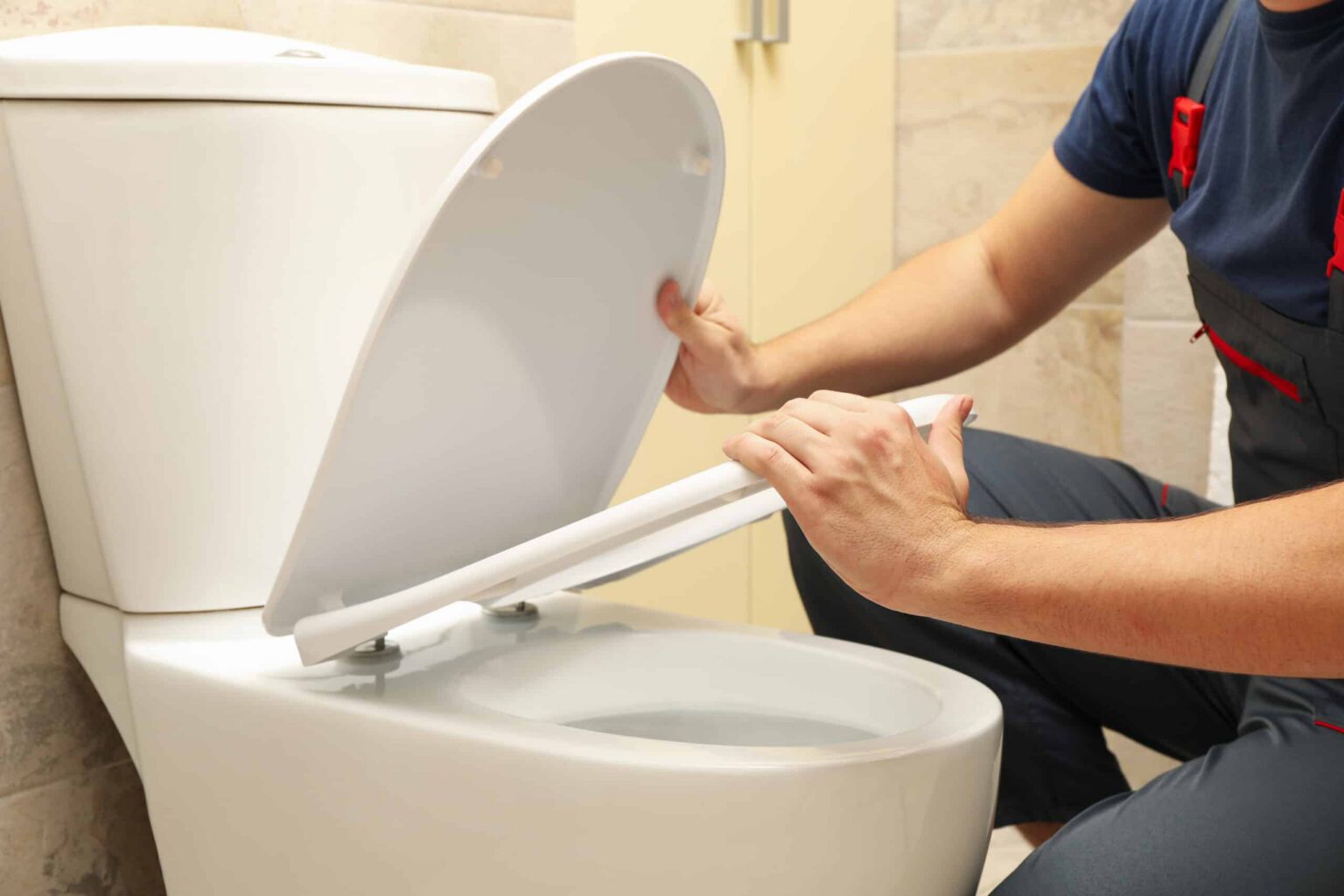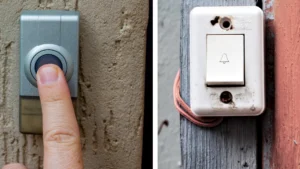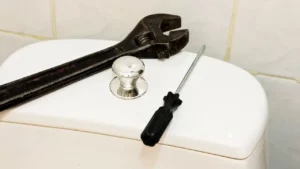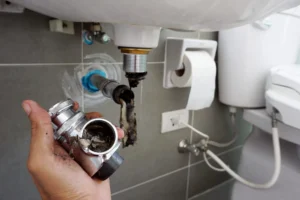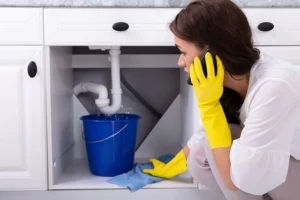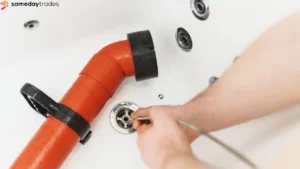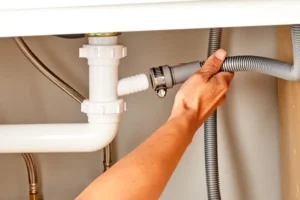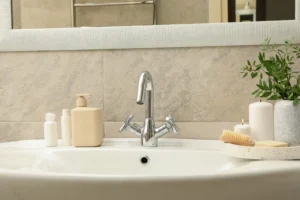A squeaky toilet seat can be quite annoying. Luckily, spray lubricant can tackle those noisy hinges. This article will show you how to fix a squeaking toilet seat with some simple steps.
Let’s get started!
Key Takeaways
– Tighten loose fittings to stop a squeaky toilet seat. Use a wrench or socket set to secure the bolts at the hinges.
– Apply spray lubricant to hinges for smooth operation and to eliminate noise. A small amount can prevent future creaks.
– Regular maintenance, like checking and tightening bolts and lubricating hinges, prevents annoying squeaks.
– If simple fixes don’t work, consider replacing cracked or broken seats or calling a professional plumber for help.
Why Does a Toilet Seat Start to Squeak?
A toilet seat often squeaks due to loose fittings. Fittings that are not tight can cause movement, leading to irritating noises.
Loose fittings
Loose fittings cause many toilet seats to squeak. Over time, the bolts securing the seat can become loose. This movement leads to creaking sounds when someone sits down or shifts position.
Tightening toilet seat bolts often resolves these issues quickly and easily.
An effective way to address this is by taking the seat off first. Test it for any noise after removing it from the toilet. If it still creaks, you may need to check other components such as hinges or brackets.
Regularly maintaining your toilet seat can prevent future problems and ensure a quieter bathroom experience.
Inadequate lubrication
Inadequate lubrication often causes a creaking toilet seat. Hinges need proper oil to operate smoothly. Spray lubricant can resolve this issue easily. Just squirt a small amount into the hinges at the back of the seat.
Many people overlook this simple fix, thinking it won’t make much difference. Testing the toilet seat after applying lubricant can help determine if that’s where the squeak comes from.
Tightening bolts also plays a crucial role in stopping noise. If bolts remain loose, they increase movement and lead to annoying sounds. Regular maintenance ensures your toilet seat functions quietly and effectively over time.
For those with soft close toilet seats, lubricating hinges prevents squeaking as well. Practicing these easy DIY steps leads to better toilet seat performance and less hassle in daily life.
How to Fix a Squeaking Toilet Seat in 5 Easy Steps
Fixing a squeaking toilet seat is easy and takes only a few minutes. Follow these simple steps to restore peace in your bathroom.
Prepare the area
To prepare the area for fixing a squeaking toilet seat, start by gathering your tools. You will need a wrench or socket set to tighten bolts and some spray lubricant for hinges. Make sure you have paper towels handy for any spills.
Clear the space around the toilet. This ensures easy access to all parts of the toilet seat. If needed, place old towels on the floor to catch any drips from lubrication. A tidy workspace helps you stay focused on resolving that irritating toilet seat noise quickly and efficiently.
Expose and secure bolts
After preparing the area, focus on exposing and securing the bolts. Start by locating the hinges at the back of your toilet seat. You might need to lift a plastic cover to reveal them.
Once visible, check if they are loose. Tightening these bolts often fixes a squeaky toilet seat. Use a wrench or socket set for this task.
Next, secure each bolt firmly but avoid overtightening; it can crack the toilet seat. A tight connection eliminates movement that causes noise. If you still hear creaking after tightening, consider lubricating the hinges next for better results in fixing a squeaky toilet seat.
Test and lubricate
After exposing and securing the bolts, it’s time to test the toilet seat. Take off the seat from the toilet and move it gently up and down. Listen for any creaking noises that reveal where the squeak comes from.
If you notice a noise, lubricate the hinges using spray lubricant. Just squirt a small amount into each hinge at the back of the seat. This simple step allows for smooth movement when you sit down.
Tightening loose bolts can also provide relief from squeaks. Make sure everything is secure before testing again. A quiet toilet seat improves your bathroom experience. Now that you’ve tested and lubricated your toilet seat, consider how to clean up after your repairs.
Clean up
Clean the area after fixing the squeaking toilet seat. Wipe down any excess lubricant from the hinges to prevent dirt build-up. Check for fallen debris around the toilet and pick it up.
Disinfect surfaces that may have been touched during repairs.
Inspect everything before putting tools away. Ensure all parts are secure, especially after tightening bolts. Regular maintenance prevents issues like toilet seat noise. Proper cleaning keeps your bathroom fresh and welcoming.
Preventing future squeaks
To prevent future squeaks on your toilet seat, regularly check the hinges. Lubricate them with spray lubricant as needed. This simple maintenance keeps them moving smoothly and stops annoying noise.
Tighten any loose bolts to keep everything secure. If a toilet seat is cracked or broken, replace it promptly to avoid creaking sounds.
For plastic hinges, apply oil to reduce squeaking over time. Inspecting and cleaning the bottom of the tank also helps maintain overall functionality. A well-maintained toilet contributes to quieter operation and less hassle in daily use, ensuring long-lasting comfort in your home.
When to Call a Professional for Noisy Toilet Seats
A professional may be needed for noisy toilet seats if tightening bolts and lubricating hinges does not stop the noise. Sometimes, cracked or broken seats require replacement. If the toilet continues to creak after repairs, call a plumber for help.
They can fix leaks or running issues that might contribute to the problem. Replacing worn-out parts often improves overall toilet performance. Regular maintenance helps prevent future squeaks and keeps your bathroom in good shape.
Conclusion
Fixing a squeaking toilet seat is simple. Follow the steps in this guide for quick results. Tighten loose bolts and add lubricant where needed. Regular maintenance keeps your toilet quiet and comfortable.
Enjoy a hassle-free experience with your repairs!

